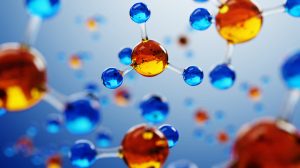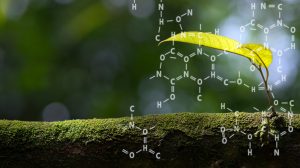Table of Contents
Definition
noun
plural: nitrogens
ni·tro·gen, ˈnɐɪtʰɹədʒən
(biochemistry) A colorless, odorless, gaseous element, represented by the symbol “N”, with an atomic number of 7 and an atomic weight of 14.0067, and one of the major elements that are biologically important for its role as a constituent in various biological compounds
Details
Overview
Nitrogen is one of the chemical elements found in nature. A chemical element refers to the pure substance of one type of atom. At present, 94 are natural elements whereas 24 are synthetic. Nitrogen is one of the most common elements in living things, together with carbon, hydrogen, and oxygen.
Properties of nitrogen
Nitrogen is a natural gaseous element with an atomic number of 7 and an atomic weight of 14.0067. In the periodic table, it belongs to the pnictogens. It is a reactive nonmetal with an electron configuration of He 2s2 2p3. The melting point of oxygen is -210.00 °C. Its density at STP is 1.2504 g/L. Its boiling point is -195.80°C. It is generally non-toxic. However, it can displace oxygen and cause asphyxiation in enclosed spaces. It can also cause nitrogen narcosis (i.e. a condition characterized by temporary mental impairment, such as euphoria, disorientation, and hallucinations) when inhaled at high partial pressures (i.e. >4 bar), such as in scuba diving reaching the depths below 100 feet.
In 18th and 19th centuries, scientists learned that the air components could be liquefied by compressing and cooling the air. The early prevailing thought was that nitrogen was a permanent, noncondensible gas. But in 1883, Polish chemists and physicists, Zygmunt Wróblewski 1845 –1888 and Karol Olszewski 1846 –1915, were the first to liquefy nitrogen (oxygen and carbon dioxide, as well) from the atmosphere. The liquid nitrogen is a colorless liquid. Its density is 0.807 g/ml at its boiling point (−195.79 °C). It is mainly used as a cryogen. At present, it is used in the cryopreservation of biological samples, such as blood and sex cells. In medicine, it is applied in cryotherapy for the removal of cysts and warts. Care should be taken during handling as it could cause cold burns on contact. Ingestion could lead to severe internal damage. Liquid nitrogen readily evaporates into nitrogen gas. When liquid nitrogen is put inside a vacuum chamber it becomes solid nitrogen.
Isotopes of nitrogen
The naturally-occurring isotopes of nitrogen are Nitrogen-14 and Nitrogen-15. Both are stable isotopes. Nitrogen-14 though is more common, accounting to the 99.63% of natural nitrogen. Nitrogen-15 is the less common stable nitrogen isotope, making up 0.37% of natural nitrogen. Nitrogen-13 is a cyclotron-produced, positron-emitting radioisotope of nitrogen. It has a half-life of 9.97 minutes. It is used in protein metabolism studies and in positron-emission tomography.
Allotropes of nitrogen
An allotrope of an element pertains to any of the multiple substances formed by only one type of element. Examples of allotropes of nitrogen are atomic nitrogen and dinitrogen. Atomic nitrogen (active nitrogen) is a very reactive allotrope of oxygen. It has three unpaired electrons and thus readily reacts with most elements. Dinitrogen (N2) (molecular or free nitrogen) is a colorless, odorless, and tasteless gas at standard conditions. Two nitrogen atoms are bound together in a triple bond (N≡N). Dinitrogen is far less reactive than atomic nitrogen. Nevertheless, it may react with certain transition metal complexes.
Nitrogenous compounds
Nitrogenous compounds
Nitric oxide (NO) is an example of nitrogen oxides. It is a stable compound and carries out important biological roles. In humans and other mammals, NO serves as a cellular signaling molecule. NO from neurons acts as a neurotransmitter. NO from macrophages serves as an antimicrobial agent. NO is involved in various biological processes. Some of them are the following: induction of vasodilation, inhibition of platelet aggregation, inhibition of the proliferation and migration of smooth myocytes, regulation of apoptosis, and maintenance of endothelial cell barrier function. It was also established to have a role in regulating multiple functions in both male and female reproductive system.1
Nitrogenous compounds
Organic compounds are fundamentally defined as those substances containing carbon atoms and Carbon-Carbon (C-C) and Carbon-Hydrogen (C-H) bonds. Examples of organic nitrogen compounds are amides, amines, imines, imides, azides, azo compounds, cyanates, isocyanates, nitrates, nitrites, nitro compounds, and so on. Nitrogen is one of the major component elements of the nitrogenous bases, nucleic acids, amino acids, and proteins.
Discovery of nitrogen
In 1772, Scottish physician Daniel Rutherford 1749 –1819 discovered nitrogen but called it noxious air (or phlogisticated air). He was able to by ridding a confined quantity of air of oxygen and carbon dioxide. What was left would primarily be nitrogen. Other chemists such as Henry Cavendish 1731 –1810 (credited for the discovery of hydrogen) were also able to isolate the gaseous element but the credit was given to Rutherford for being the first to publish his discovery.
The English name nitrogen was adopted from the French term nitrogène proposed by the French chemist Jean-Antoine-Claude Chaptal 1756 –1832 in 1790 since it was found to occur in nitric acid and nitrates.
Biological importance
In biology, nitrogen plays a crucial role in various biochemical and physiological processes. It is one of the most abundant elements in the human body: oxygen (65% by mass), carbon (18.5%), hydrogen (9.5%), nitrogen (3.2%), calcium (1.5%), and phosphorus (1%).
Nitrogen serves as an important component of nucleic acids (DNA and RNA) and proteins. DNA contains the genetic information for cell growth, division, and function. RNA has an important role in protein synthesis, gene regulation, and DNA replication. Both of them are made up of nucleotides. A nucleotide, in turn, is made up of phosphates, sugars, and nitrogenous bases. Nitrogen is a component of a nitrogenous base. Proteins are molecules made up of amino acids attached together by peptide bonds. An amino acid is made up of amino group (NH2), carboxylic acid group (COOH), a hydrogen atom, and an organic side group (R). The amino group is a basic and hydrophilic compound consisting of nitrogen and hydrogen with the formula of NH2. Thus, the breakdown of amino acids in a decaying matter releases amines. Apart from amino acids, amines are also present in several neurotransmitters, e.g. epinephrine, norepinephrine, dopamine, serotonin, and histamine. Nitrogen is also present in other biological compounds, such as heme in hemoglobin, NTps (e.g. ATP), electron-carriers (e.g. NADH, NAD, NADP), and chlorophyll (formula: C55H72O5N4Mg).
Nitrogen in the atmosphere and the soil cannot be used by many organisms, including humans. Humans derive nitrogen largely from a nitrogen-containing diet. Nitrogen has to be fixed (a process called nitrogen fixation) to be converted into another form (e.g. NO, nitric acid, nitrites, nitrates) that can be metabolized. Most plants derive their nitrogen from the soil as nitrates and ammonium. Some plants, such as legumes, have endosymbionts that fix nitrogen for them.
Nitrogen cycle
Nitrogen is one of the most abundant elements in the universe by mass (ppm), after hydrogen, helium, oxygen, carbon, neon, and iron. On Earth’s atmosphere, it is the most abundant gas by volume. It makes up about 78%. Oxygen is only next to it, making up about 21%.2
The form of nitrogen in the atmosphere (i.e. nitrogen gas, N2) is not very reactive and most living things cannot metabolize it directly. The unreactive nature of nitrogen gas is due to the triple bonds that bond the two nitrogen atoms. This bond cannot easily break; it takes higher energy to do so.
Nitrogen gas alone cannot sustain life. Thus, it was earlier referred to as noxious gas. However, as mentioned earlier, it is biologically important. It is one of the major components of many biological compounds, together with the other three elements: carbon, hydrogen, and oxygen. A mnemonic acronym for these four common elements in living things is “CHON”.
One of the ways through which N2 can be used is to convert it to another form. It is through a process called nitrogen fixation. There are two fundamental ways. One is non-biological in nature. Electrical energy on the atmosphere (e.g. lightning) dissociates nitrogen and oxygen molecules to liberate free atoms that subsequently forms nitric oxide (NO) and nitrogen dioxide (NO2). NO2 can then react with water (H 2O) to produce nitric acid (HNO3) and NO. The nitric acid falls down as a diluted solution in the rain. In the soil, it is neutralized and converted into nitrogenous compounds, e.g. nitrites, and nitrates.3
Another way to fix nitrogen is through a biological process. Certain microorganisms (e.g. cyanobacteria, green sulfur bacteria, Azotobacteraceae, Clostridium spp., some methanogenic archaea) can use nitrogen gas directly from the air and then convert it into nitrogenous compounds.
The microbes capable of fixing nitrogen are called nitrogen-fixers or diazotrophs. They produce an enzyme (called nitrogenase) that converts nitrogen gas to ammonia. The overall reaction is as follows:
N2 + 16 ATP + 8e– + 8H+ → 2NH3 + H2 + 16ADP16Pi
Ammonia (NH3), in turn, is converted into nitrite ions through a process called nitrification. The nitrite ions can then be absorbed by plants through their roots. Animals, in turn, gain access to nitrogenous compounds by consuming plants.
Rhizobia are also diazotrophs but they do so while living inside the root nodules of leguminous plants. In return, the legumes provide the rhizobia an anoxic habitat (i.e. root nodules) since nitrogenases are easily degraded by the presence of oxygen. The legumes produce leghemoglobin that binds to oxygen in the root nodules that houses rhizobia. Other symbiotic diazotrophs are Frankia bacteria in the root nodules of Actinorhizal plants and cyanobacteria in symbiosis with various groups (e.g. fungi in lichens, liverworts, fern, cycad). Some diazotrophs have been found to inhabit guts of various animals (e.g. termites, shipworms) where they contribute ammonia. These symbiotic microbes provide their hosts nitrogenous compounds that the latter can directly use.
Nitrogen returns to the soil and air when organisms deposit nitrogen compounds or when they die and decay. Some microorganisms are capable of using nitrogen compounds and release nitrogen gas back to the air through a biological process called denitrification.
There is yet another way of fixing nitrogen. Nitrogen gas becomes highly reactive when the temperature is high. When fuel is burned nitrogen oxide compounds form. NO2, for instance, can form from combustion. Thus, it may be emitted from factories and automobiles. Apparently, NO2 reacts with water in the atmosphere, and consequently, serves as one of the factors that led to the formation of acid rain.3
Another man-made source of fixed nitrogen is the introduction of artificial fertilizers into the soil for agriculture. The most common method is the Haber process utilizing high pressures (about 200 atm) and temperatures (e.g. 400 °C) for industrial catalysis. At present, fertilization production is the largest source of man-made fixed nitrogen in the ecosystem.
Supplementary
Etymology
- French nitrogène, from Ancient Greek νίτρον (nítron) + γενής (-genēs, meaning “producer”)
Symbol
Derived terms
- Blood urea nitrogen
- Nitrogen base
- Nitrogen Cycle
- Nitrogen Deficiency
- Nitrogen fixation
- Nitrogen monoxide
- Nitrogen mustard compounds
- Nitrogen narcosis
- Nitrogen oxides
- Nitrogen partition
- Nitrogen radioisotopes
- Nitrogen-13
- Nitrogen-14
- Nitrogen-15
- Nitrogenous
- Nonprotein nitrogen
- Rest nitrogen
Further reading
See also
- element
- ammonia
- nitrites
- nitrate
- nitrogenase
- nitrogenous base
- nucleic acid
- protein
- acid rain
Reference
- Rosselli, M, Keller, P. J., & Dubey, R. K. (1998). Role of nitric oxide in the biology, physiology and pathophysiology of reproduction. Human Reproduction Update, 4(1), 3–24. ://doi.org/10.1093/humupd/4.1.3 Link
- Earth Fact Sheet. (2000, January 1). Retrieved from ://nssdc.gsfc.nasa.gov/planetary/factsheet/earthfact.html Link
- Sanderson, R. T. (2018, November 23). Nitrogen – Biological and physiological significance. In Encyclopædia Britannica. Retrieved from ://www.britannica.com/science/nitrogen/Biological-and-physiological-significance Link
© Biology Online. Content provided and moderated by Biology Online Editors







